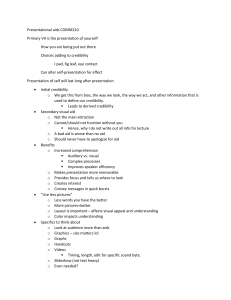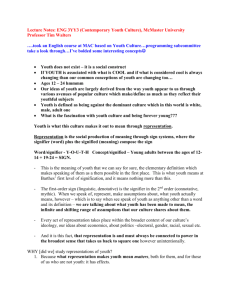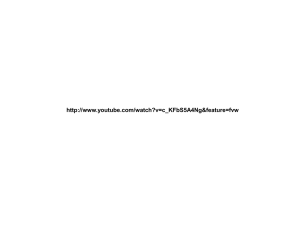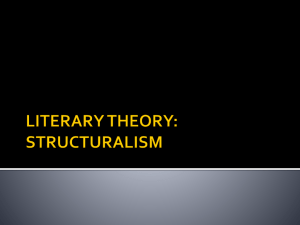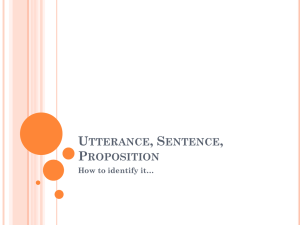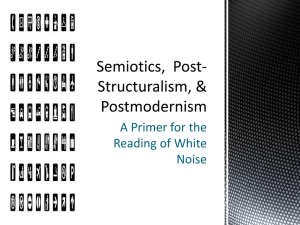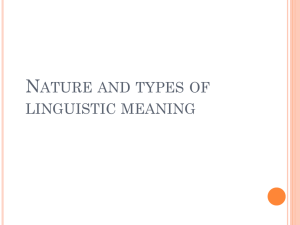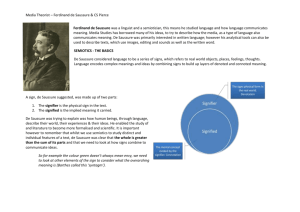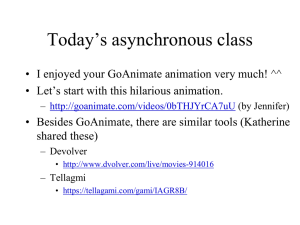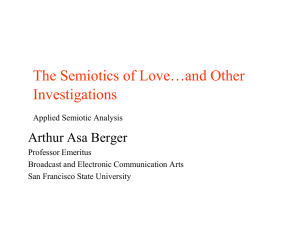semiotics 1 notes
advertisement
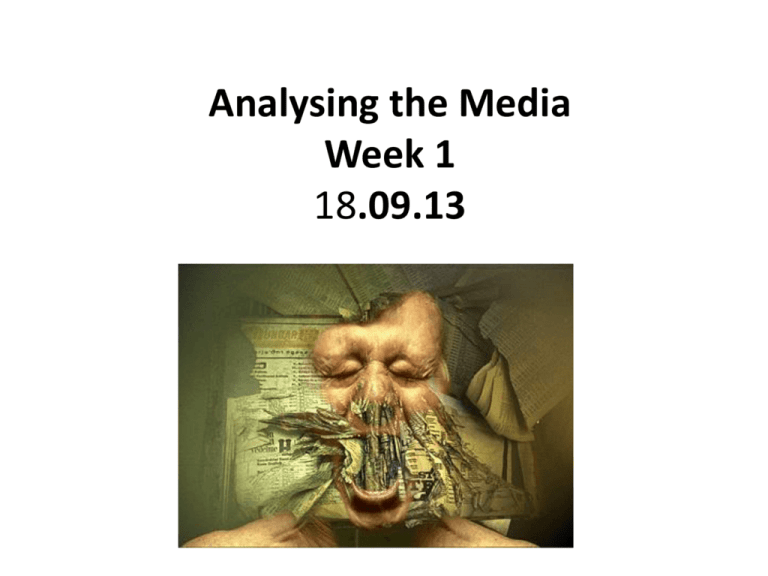
Analysing the Media
Week 1
18.09.13
Course Description
Your course
description and
assessment
requirements will
be distributed to
you on an A4
sheet, in class.
Please file this
information,
carefully.
Semiology
Swiss linguist Ferdinand
de Saussure (1857 1913) embarked on the
study of signs in order
to explain language
better. He called this
study Semiology.
Semiotics: ‘the life of signs within
society’ (Saussure)
• Exploring language and
meaning at the same
time as Saussure,
Charles Pierce (1839 1914), coined the term
Semiotics. It is derived
from the Greek word
semeîon = sign.
Semiotics as it is more
usually known, is,
therefore, the study of
signs.
‘Nothing is a sign unless it is
interpreted as a sign.’ (Peirce)
• A sign is something which
symbolizes or represents
more than one meaning.
• In a semiotic sense signs take
the form of words, images,
sounds, odours, flavours, acts,
gestures and objects.
(Chandler, Introduction:
1/Signs 1)
• A sign consists of a signifier the form which the sign takes;
and a signified – the concept
it represents.
Signs
• ‘A sign is quite simply a thing,
whether object, word or
picture – which has a
particular meaning to a person
or group of people. It is
neither the thing nor the
meaning alone, but the two
together.
• The sign consists of the
Signifier, the material object
and the Signified, which is its
meaning. These are only
divided for analytical
purposes: in practice a sign is
always the thing-plusmeaning. (Williamson, 1978 p. 17)
You can’t use a bulldozer to study orchids
• The Death of Ferdinand
de Saussure
http://www.youtube.co
m/watch?v=2vykJ7UgNQ
• (The Magnetic Fields,
69 Love Songs, 1999)
Conventions
• A convention is a shared
understanding or an
agreement about how
something should
look/sound/be etc. reached
over time by a community
of users of the same
medium or inhabitants of
the same culture etc.
• The sign on mens’ toilets is
conventional but also
somewhat motivational
(the figure does bear some
resemblance to a man).
How do these signs play with convention?
What do they signify?
Over to you...
What are the conventions
associated ...
• with tragedy?
• the main news bulletin?
• a map?
• a piece of heavy metal
music?
• the word ‘Mná’?
Ceci n’est pas un pipe, René
Magritte (1928 -29)
• Arbitrary relationships exist
between signifiers and signified
i.e. between words such as
tree/ arbre, house/ maison and
that thing which the word is
describing. Signifieds can also
be arbitrary.
• N.B. foot-wrist. The
relationships between signifiers
and signifieds in signs can be
more or less conventional,
more or less motivated – from
the totally arbitrary and
consequently conventional in
verbal language (tree/arbre) to
the minimally arbitrated or
clearly motivated in
straightforward photography.
‘That which we call a rose by any other name would
smell as sweet’ (Shakespeare)
Denotation and Connotation
•
•
•
•
•
•
•
Denotation is the image or signifier –
what is contained in the image.
Connotation takes the first order
signification - signifier and signified and attaches a second order signified
to it.
Examples: a rose, the American bald
eagle, a swastika, Eminem…Can you
explain what these signs denote and
connote? Can you think of any other
signs like these?
Clip: Jezebel (William Wyler, USA,
1938).
http://www.youtube.com/watch?v=A
SNO9QuKLj0
Types of sign (Pierce)
• Symbol/symbolic: a mode
in which the signifier does
not resemble the signified
but which is fundamentally
arbitrary or purely
conventional - so that the
relationship must be learnt:
e.g. language in general
(plus specific languages,
alphabetical letters,
punctuation marks, words,
phrases and sentences),
numbers, morse code,
traffic lights, national flags
etc. Symbolic signs are used
a lot in advertising: visuals,
music, jingles etc..
Types of Sign (2)
• Icon/iconic: a mode in which
the signifier is perceived as
resembling or imitating the
signified (recognizably looking,
sounding, feeling, tasting or
smelling like it) - being similar
in possessing some of its
qualities: e.g. a portrait, a
cartoon, a scale-model,
onomatopoeia, metaphors,
'realistic' sounds in
'programme music', sound
effects in radio drama, a
dubbed film soundtrack,
imitative gestures..
• Index/indexical: a mode in which the signifier is not
arbitrary but is directly connected in some way
(physically or causally) to the signified - this link can be
observed or inferred: e.g. 'natural signs' (smoke,
thunder, footprints, echoes, non-synthetic odours and
flavours), medical symptoms (pain, a rash, pulse-rate),
measuring instruments (weathercock, thermometer,
clock, spirit-level), 'signals' (a knock on a door, a phone
ringing), pointers (a pointing 'index' finger, a directional
signpost), recordings (a photograph, a film, video or
television shot, an audio-recorded voice), personal
'trademarks' (handwriting, catchphrase) and indexical
words ('that', 'this', 'here', 'there').
Useful ideas
• Structuring/binary
opposites: e.g. hot/cold,
old/new/black/white
etc
• Negative differentiation
- The thing is that which
it is not.
• ‘Sign value’ and ‘Sign
wars’ in advertising.
Viewing
Viewing
• The Century of the Self (Adam Curtis, BBC,
2002). A documentary exploring the ideas of
Edward Bernays, the ‘inventor’ of PR and
nephew of Sigmund Freud.
http://www.youtube.com/watch?v=IyPzGUsYy
KM
Further reading:
• Judith Williamson Decoding Advertisements, London,
Marion Boyars, 1978.
• Daniel Chandler Semiotics for Beginners at
http://www.aber.ac.uk/media/Documents/S4B/ (This is a
very comprehensive online resource on the area, however
the level of detail is quite high and the material requires
study. So, it’s there as a back-up if you’re really, really
interested in semiotics).
• For next week: Choose a magazine ad and try to analyse it
using the tools and terminology of semiotics. Bring your ad
and analysis to class with you.
Home Viewing
• The Persuaders, a 2004
US PBS film about the
methods through which
advertising constantly
seeks to surround and
engage us.
• http://www.pbs.org/wg
bh/pages/frontline/sho
ws/persuaders/
• When watching The
Persuaders try to
identify differentiation,
negative differentiation
(“not-signs”) or parody
as they may occur in ads
in the film.

